Abstract
Bacteria of the tribe Klebsielleae are capable of metabolizing the cyclitols myoinositol, sequoyitol, and pinitol, which are present in aqueous extracts of redwood. Of the combined Klebsiella isolates from clinical and environmental origins, 100% (138/138), 97% (34/35), and 86% (119/138) fermented inositol, sequoyitol, and pinitol, respectively. These compounds were also used as a sole source of carbon and energy by Klebsiella. Similar results were obtained with Enterobacter isolates, but most other enteric bacteria tested could not metabolize cyclitols. Strains of Klebsiella multiplied to levels exceeding 10(5)/ml in aqueous extracts of nonsterile redwood within 6 days. Most other enteric bacteria did not grow in these extracts. Cyclitol metabolism was found to correlate well with the ability to multiply in redwood extract in the presence of cyclitol-negative indigenous bacteria. The capacity to use cyclitols, which are present in a variety of plant material, might afford Klebsielleae of both environmental and clinical origins an advantage in competing for nutrients and colonizing botanical environments.
Full text
PDF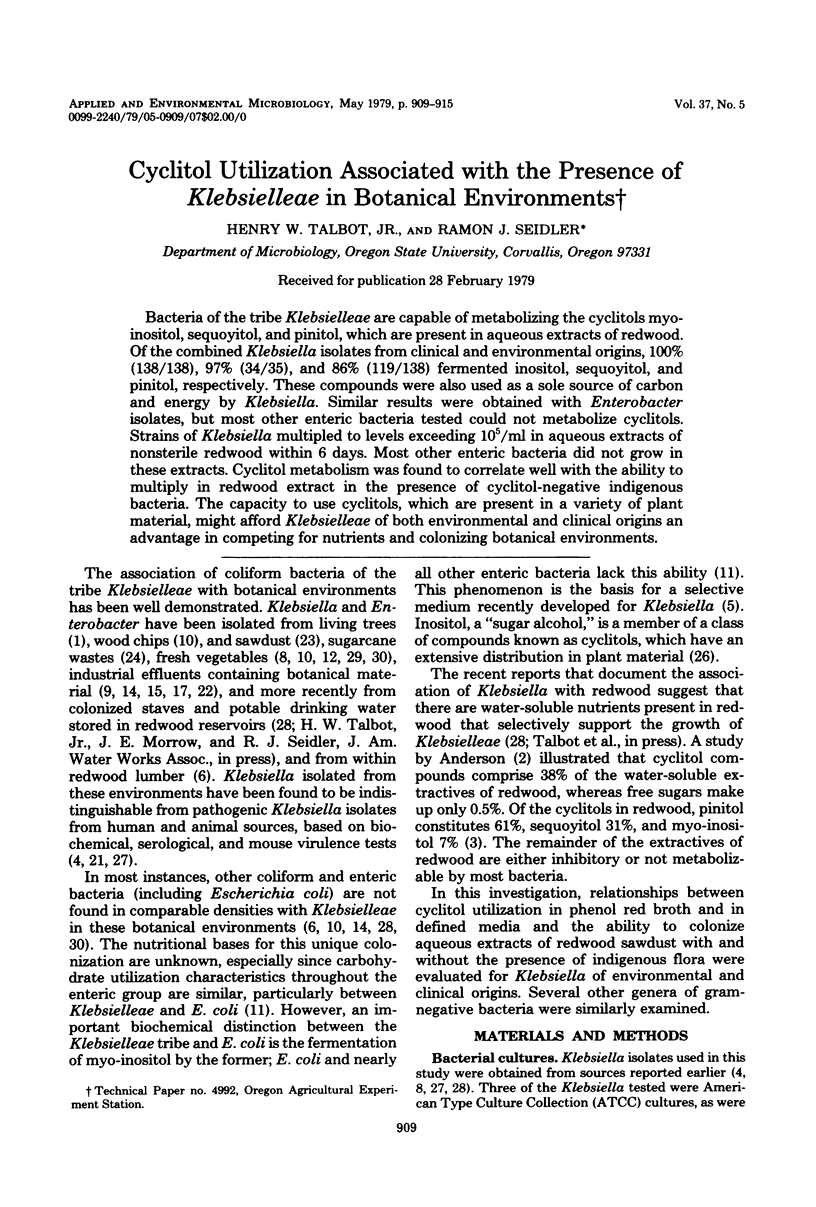
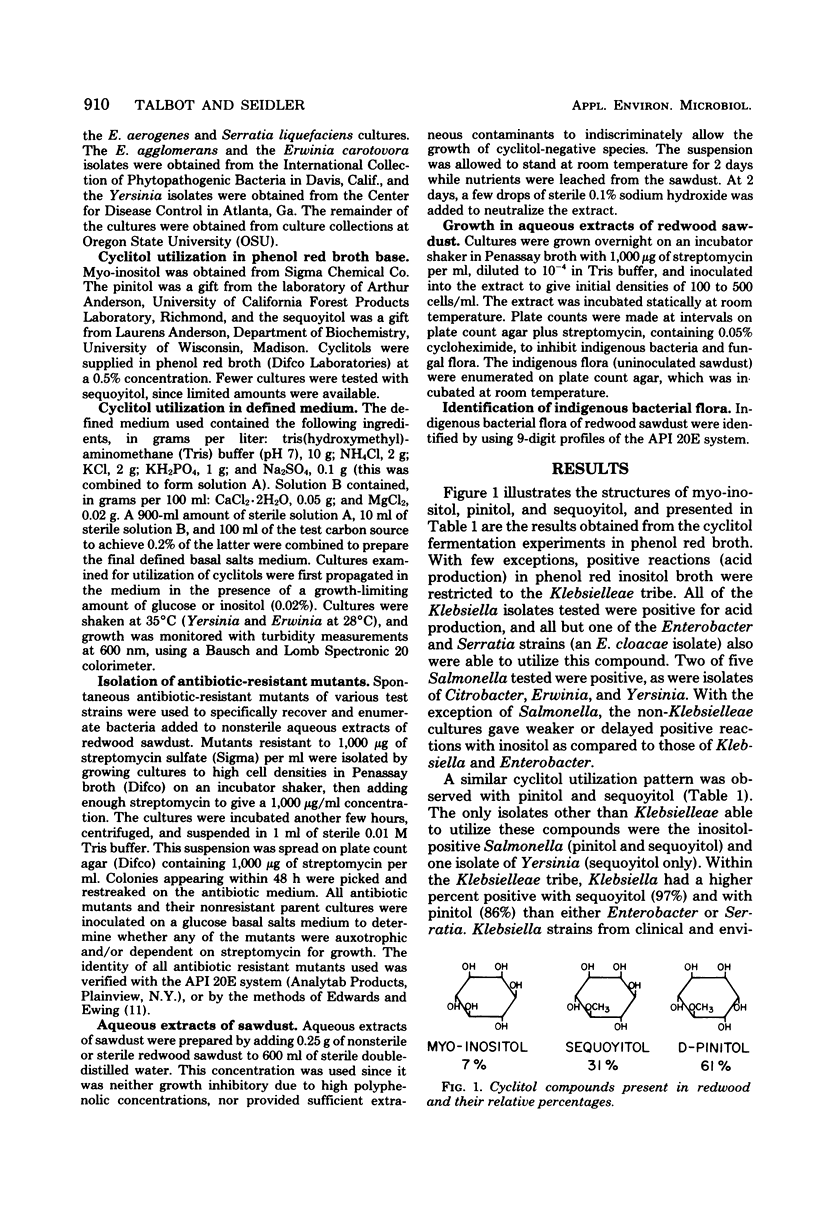
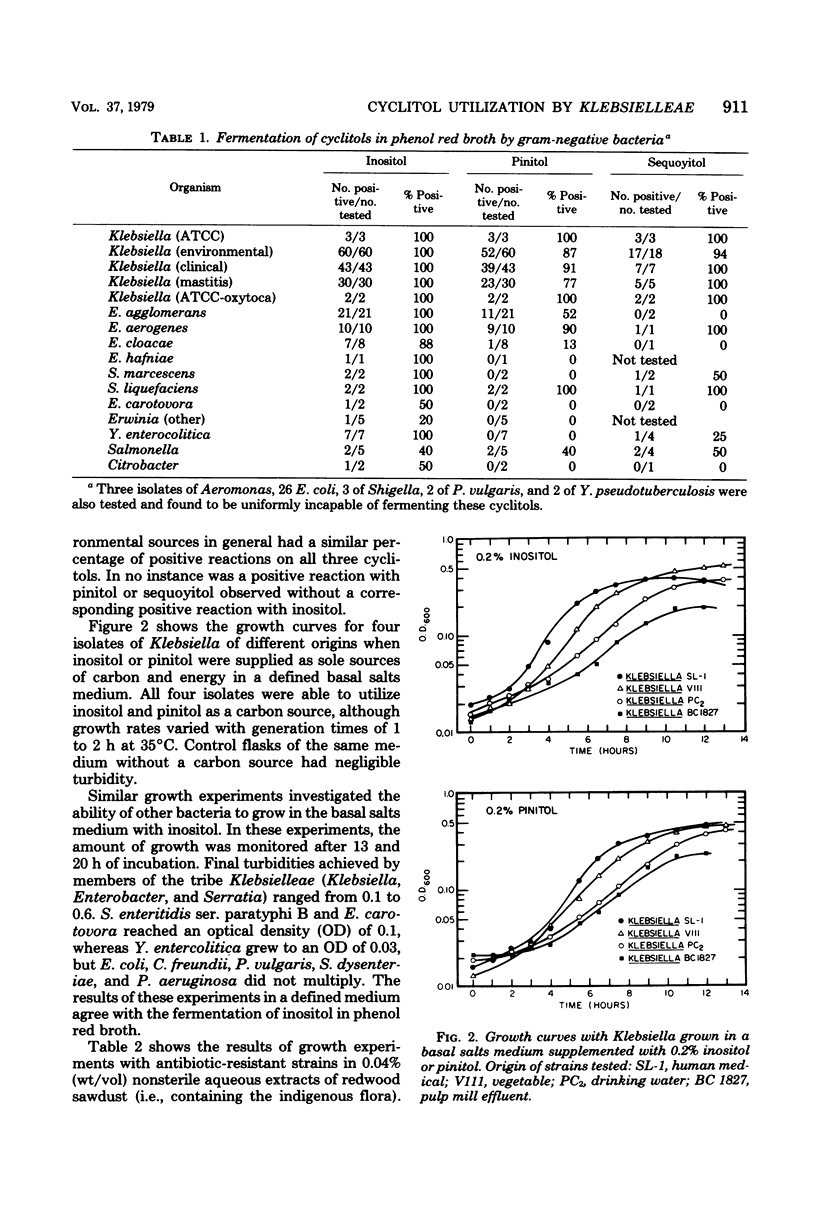
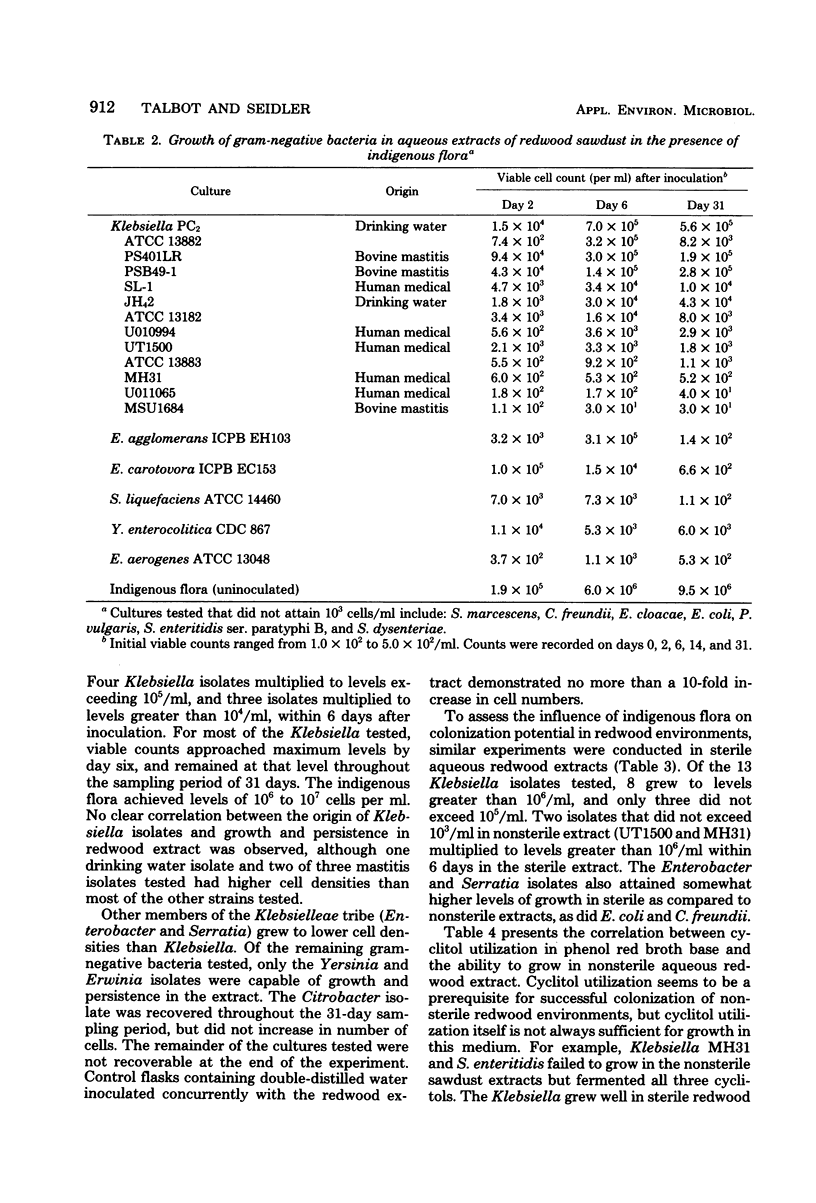
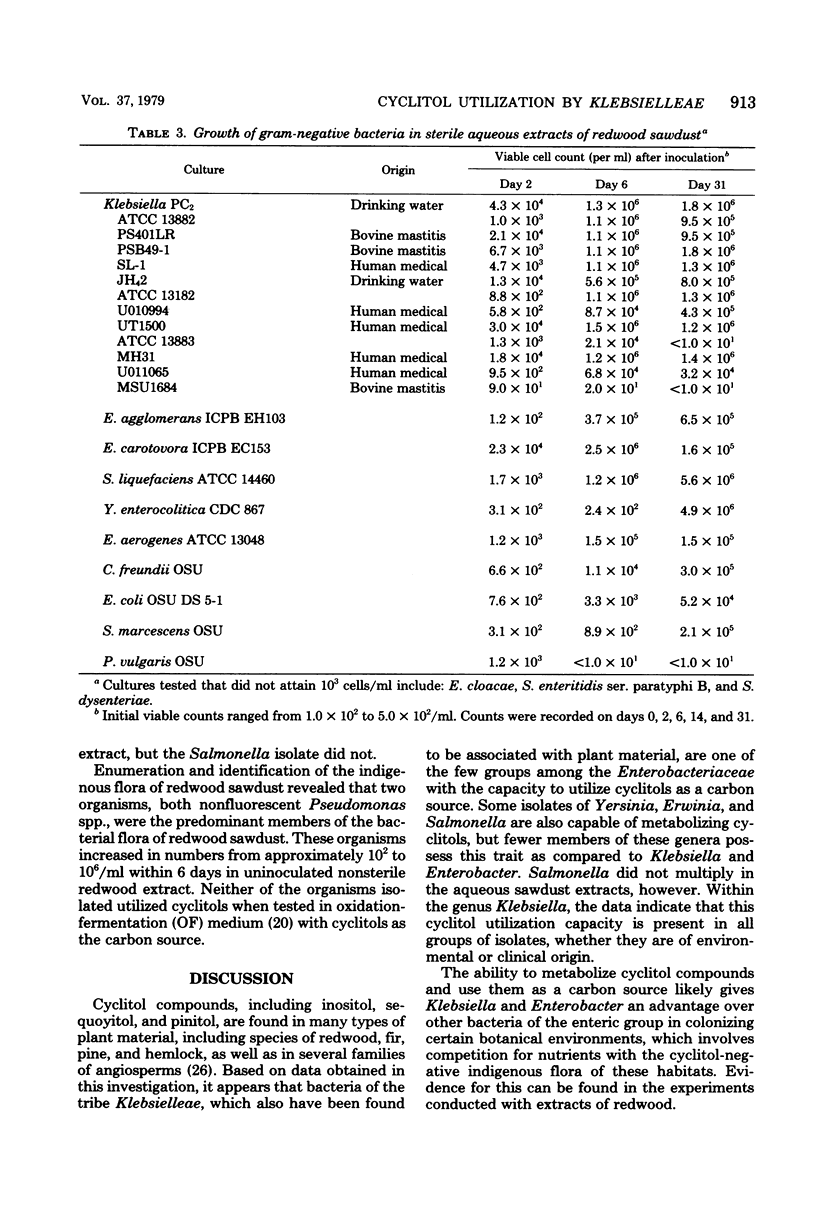
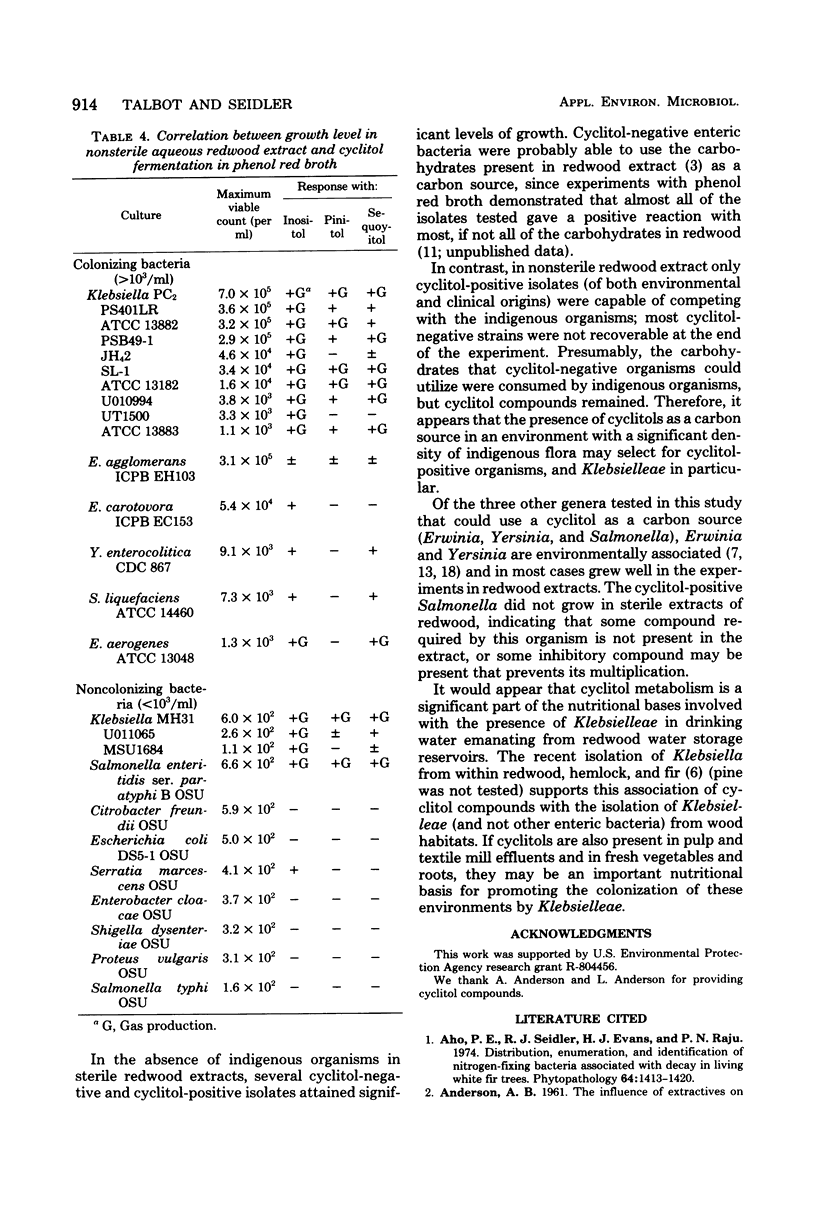
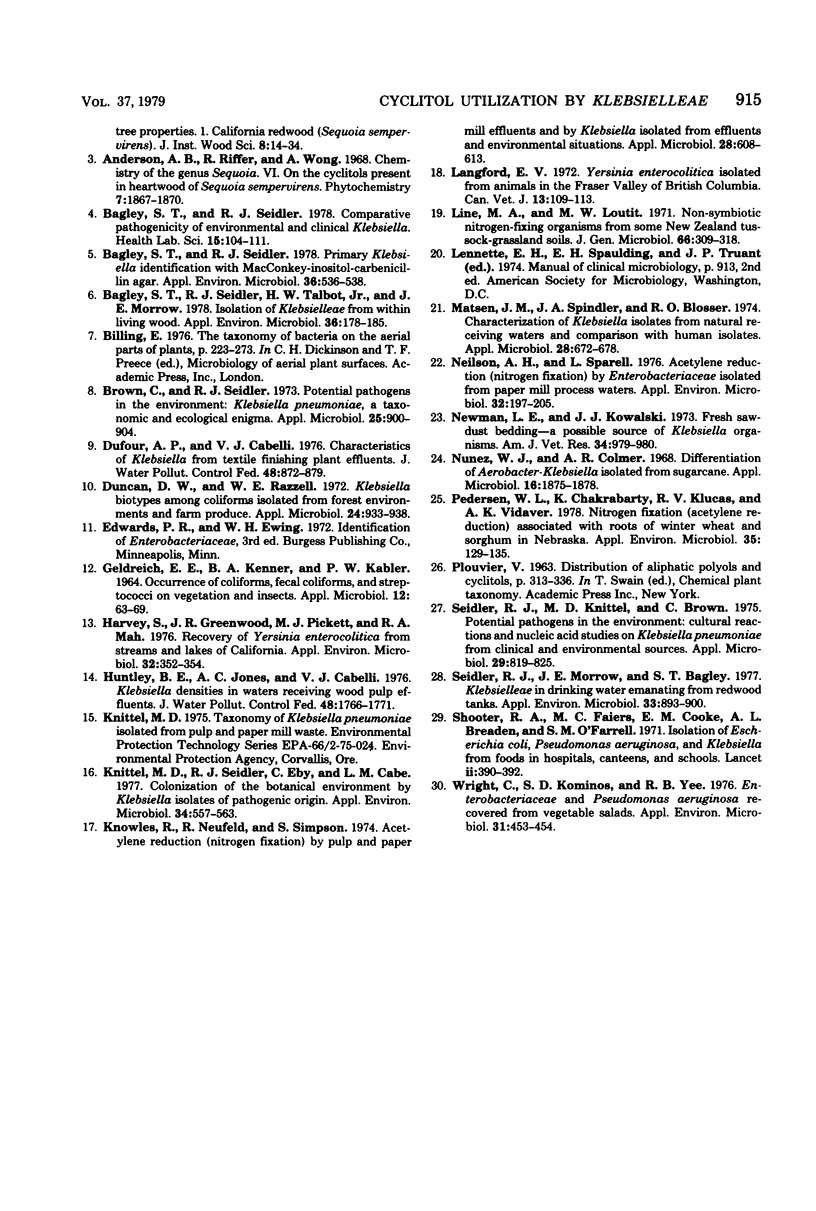
Selected References
These references are in PubMed. This may not be the complete list of references from this article.
- Bagley S. T., Seidler R. J. Comparative pathogenicity of environmental and clinical Klebsiella. Health Lab Sci. 1978 Apr;15(2):104–111. [PubMed] [Google Scholar]
- Bagley S. T., Seidler R. J. Primary Klebsiella identification with MacConkey-inositol-carbenicillin agar. Appl Environ Microbiol. 1978 Sep;36(3):536–538. doi: 10.1128/aem.36.3.536-538.1978. [DOI] [PMC free article] [PubMed] [Google Scholar]
- Bagley S. T., Seidler R. J., Talbot H. W., Jr, Morrow J. E. Isolation of Klebsielleae from within living wood. Appl Environ Microbiol. 1978 Jul;36(1):178–185. doi: 10.1128/aem.36.1.178-185.1978. [DOI] [PMC free article] [PubMed] [Google Scholar]
- Brown C., Seidler R. J. Potential pathogens in the environment: Klebsiella pneumoniae, a taxonomic and ecological enigma. Appl Microbiol. 1973 Jun;25(6):900–904. doi: 10.1128/am.25.6.900-904.1973. [DOI] [PMC free article] [PubMed] [Google Scholar]
- Dufour A. P., Cabelli V. J. Charateristics of Klebsiella from textile finishing plant effluents. J Water Pollut Control Fed. 1976 May;48(5):872–879. [PubMed] [Google Scholar]
- Duncan D. W., Razzell W. E. Klebsiella biotypes among coliforms isolated from forest environments and farm produce. Appl Microbiol. 1972 Dec;24(6):933–938. doi: 10.1128/am.24.6.933-938.1972. [DOI] [PMC free article] [PubMed] [Google Scholar]
- GELDREICH E. E., KENNER B. A., KABLER P. W. OCCURRENCE OF COLIFORMS, FECAL COLIFORMS, AND STREPTOCOCCI ON VEGETATION AND INSECTS. Appl Microbiol. 1964 Jan;12:63–69. doi: 10.1128/am.12.1.63-69.1964. [DOI] [PMC free article] [PubMed] [Google Scholar]
- Harvey S., Greenwood J. R., Pickett M. J., Mah R. A. Recovery of Yersinia enterocolitica from streams and lakes of California. Appl Environ Microbiol. 1976 Sep;32(3):352–354. doi: 10.1128/aem.32.3.352-354.1976. [DOI] [PMC free article] [PubMed] [Google Scholar]
- Huntley B. E., Jones A. C., Cabelli V. J. Klebsiella densities in waters receiving wood pulp effluents. J Water Pollut Control Fed. 1976 Jul;48(7):1766–1771. [PubMed] [Google Scholar]
- Knittel M. D., Seidler R. J., Eby C., Cabe L. M. Colonization of the botanical environment by Klebsiella isolates of pathogenic origin. Appl Environ Microbiol. 1977 Nov;34(5):557–563. doi: 10.1128/aem.34.5.557-563.1977. [DOI] [PMC free article] [PubMed] [Google Scholar]
- Knowles R., Neufeld R., Simpson S. Acetylene reduction (nitrogen fixation) by pulp and paper mill effluents and by Klebsiella isolated from effluents and environmental situations. Appl Microbiol. 1974 Oct;28(4):608–613. doi: 10.1128/am.28.4.608-613.1974. [DOI] [PMC free article] [PubMed] [Google Scholar]
- Langford E. V. Yersinia enterocolitica isolated from animals in the Fraser Valley of British Columbia. Can Vet J. 1972 May;13(5):109–113. [PMC free article] [PubMed] [Google Scholar]
- Matsen J. M., Spindler J. A., Blosser R. O. Characterization of Klebsiella isolates from natural receiving waters and comparison with human isolates. Appl Microbiol. 1974 Oct;28(4):672–678. doi: 10.1128/am.28.4.672-678.1974. [DOI] [PMC free article] [PubMed] [Google Scholar]
- Neilson A. H., Sparell L. Acetylene reduction (nitrogen fixation) by enterobacteriaceae isolated from paper mill process waters. Appl Environ Microbiol. 1976 Aug;32(2):197–205. doi: 10.1128/aem.32.2.197-205.1976. [DOI] [PMC free article] [PubMed] [Google Scholar]
- Newman L. E., Kowalski J. J. Fresh sawdust bedding--a possible source of Klebsiella organisms. Am J Vet Res. 1973 Jul;34(7):979–980. [PubMed] [Google Scholar]
- Nunez W. J., Colmer A. R. Differentiation of Aerobacter-Klebsiella isolated from sugarcane. Appl Microbiol. 1968 Dec;16(12):1875–1878. doi: 10.1128/am.16.12.1875-1878.1968. [DOI] [PMC free article] [PubMed] [Google Scholar]
- Pedersen W. L., Chakrabarty K., Klucas R. V., Vidaver A. K. Nitrogen fixation (acetylene reduction) associated with roots of winter wheat and sorghum in Nebraska. Appl Environ Microbiol. 1978 Jan;35(1):129–135. doi: 10.1128/aem.35.1.129-135.1978. [DOI] [PMC free article] [PubMed] [Google Scholar]
- Seidler R. J., Knittel M. D., Brown C. Potential pathogens in the environment: cultural reactions and nucleic acid studies on Klebsiella pneumoniae from clinical and environmental sources. Appl Microbiol. 1975 Jun;29(6):819–825. doi: 10.1128/am.29.6.819-825.1975. [DOI] [PMC free article] [PubMed] [Google Scholar]
- Seidler R. J., Morrow J. E., Bagley S. T. Klebsielleae in drinking water emanating from redwood tanks. Appl Environ Microbiol. 1977 Apr;33(4):893–900. doi: 10.1128/aem.33.4.893-900.1977. [DOI] [PMC free article] [PubMed] [Google Scholar]
- Shooter R. A., Cooke E. M., Faiers M. C., Breaden A. L., O'Farrell S. M. Isolation of Escherichia coli, Pseudomonas aeruginosa, and Klebsiella from food in hospitals, canteens, and schools. Lancet. 1971 Aug 21;2(7721):390–392. doi: 10.1016/s0140-6736(71)90111-5. [DOI] [PubMed] [Google Scholar]
- Wright C., Kominos S. D., Yee R. B. Enterobacteriaceae and Pseudomonas aeruginosa recovered from vegetable salads. Appl Environ Microbiol. 1976 Mar;31(3):453–454. doi: 10.1128/aem.31.3.453-454.1976. [DOI] [PMC free article] [PubMed] [Google Scholar]


